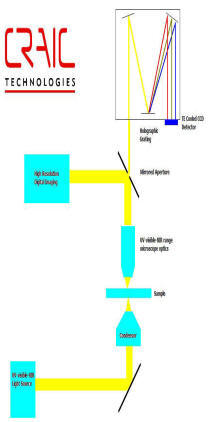Learn more about microscope objective classes

Microscope Objectives
Microscope objectives can be quite complex devices using either lenses or mirrors to collect and focus light. There are two basic designs for ultraviolet-visible-NIR capable objectives:
- Quartz Objective: Also called an Ultrafluar objective, this type of objective uses lenses made of quartz with air mounts to collect and focus light. The advantages of this type of objective are a good image quality with no spherical aberration as well as collecting more energy. However as lenses are being used, it will have some chromatic aberration in addition to limitations of spectral range and a short working distance.
- Schwarzschild Objective: Also called "mirror objectives" or "reflecting objectives", these objectives use two parabolic mirrors to collect and focus light. The advantages are a very broad range from the deep UV to the near IR with no chromatic aberration and a long working distance. A disadvantage is that, if not properly aligned, they can exhibit a spherical aberration and degraded image quality.
Objectives are defined by a number of factors, some of which include the magnification, resolving power, numerical aperture and working distance.
- Magnification: the amount that the image is magnified by the objective. The range of useful magnification is arbitrarily defined as 500 to 1000 times the numerical aperture of the objective. Magnifications above these values do not yield higher resolution of sample detail.
- Resolving power: the smallest feature that can be distinguished. The objective is just one component that defines the resolving power of the microscope "system". There are a number of ways to approximate the resolving power of an objective with the simplest being R = w / 2(NA) where R is the theoretical maximum resolving power of the objective, w is the wavelength of the light and NA is the numerical aperture of the objective. As can be seen, using a shorter wavelength of light or a higher NA objective means a better spatial resolution.
- Numerical Aperture (NA): a measure of the ability of the objective to gather light. It is defined as NA = n(sin q) where n is the refractive index of the imaging media and q is the half-angle of the maximum cone of light that can enter the objective.
- Working Distance: the distance between the front lens of the objective and the sample surface when the specimen is in focus.

